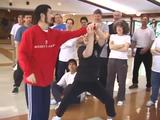It was a beautiful morning in Phoenix, Arizona. Went to my Tai Chi class at 7:30am. Adam, Albert, and Peter were already there. After positive circles, negatives circles, and fetching water exercise, we went through Yilu once. Then, I worked with Albert individually to help him learn the new moves, while Adam and Peter were doing more Yilu.
The role of the mind came into my thoughts when I was watching Albert. He’s a beginner. He’s still working with hand foot placement and choreographic part of Yilu. Do I need to mention the “mind”? Yes, I need to. Though, at this stage, the “mind” is merely the “awareness” (of the body), remembering the fundamental hand/elbow, hip/knee relations (elbow in, hand out, etc.).
After Adam and Peter finished their Yilu, they came by. So, I decided today’s topic would be the role of the mind, continuing my previous thought process. Adam and Peter are more advanced students. They have already remembered the sequence of Yilu. They have decent positive and negative circles. Their shoulders and elbows are down most of the time. They also have been working on push hands. I consider they are competent in their form practice. After the electrician lays out the electric lines, he needs to turn on the electricity to light the bulbs. So, when their body mechanics and structures are ready, in order to advance, they need to start to put their mind into their routine practice, and push hands.
I let Adam and Peter work with each other, one pushes the other with both hands at his shoulders. The person being pushed try not to fight at the shoulders, instead, adjust posture (slightly) so that the in-coming force is directed to his rear foot. In this case, the upper and lower body in connected. Keep that connected structure, when one pushes again, this time try to use the mind to direct the in-coming force, and it works. The reason I let one to push the other at shoulders, it’s easier to let the person being pushed to adjust and get connected. Through training, hopefully they can respond with the mind as soon as the opponent touches him. Here, the premise to respond with the mind is that the person has already had solid body mechanics in his training.
This also reminds an old saying in Tai Chi “用意不用力 (use mind, not force).” But don’t get confused with this “mind.” It’s not a day-dream, in which one can push an opponent to the ground by blowing a breath at him. When your body mechanics is correct based on our Practical Method, you really don’t need to use force. “Peng” is produced by our mind when our body is connected. If I can direct the opponent’s in-coming force to the ground without pushing back, he will feel as if I am pushing back toward him. There’s also a test you can try. A pushes B. When A suddenly moves back, if B stays without moving forward, I can say B is connected. If B falls forward, that tells me B is using upper body force to fight with A. To correct this (fighting back), try to use the “mind.”
This is just a thought came into my mind this morning. I think it’s worth to discuss this topic.


